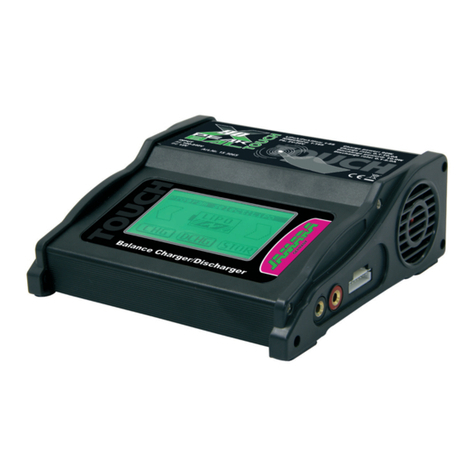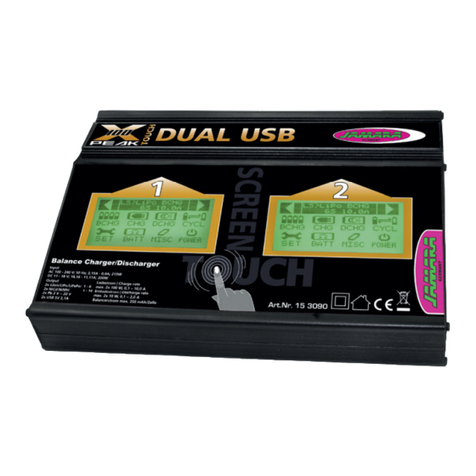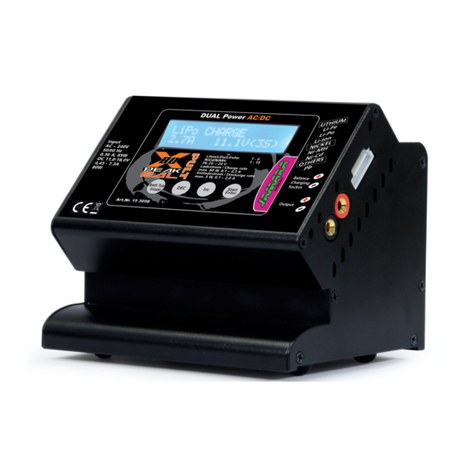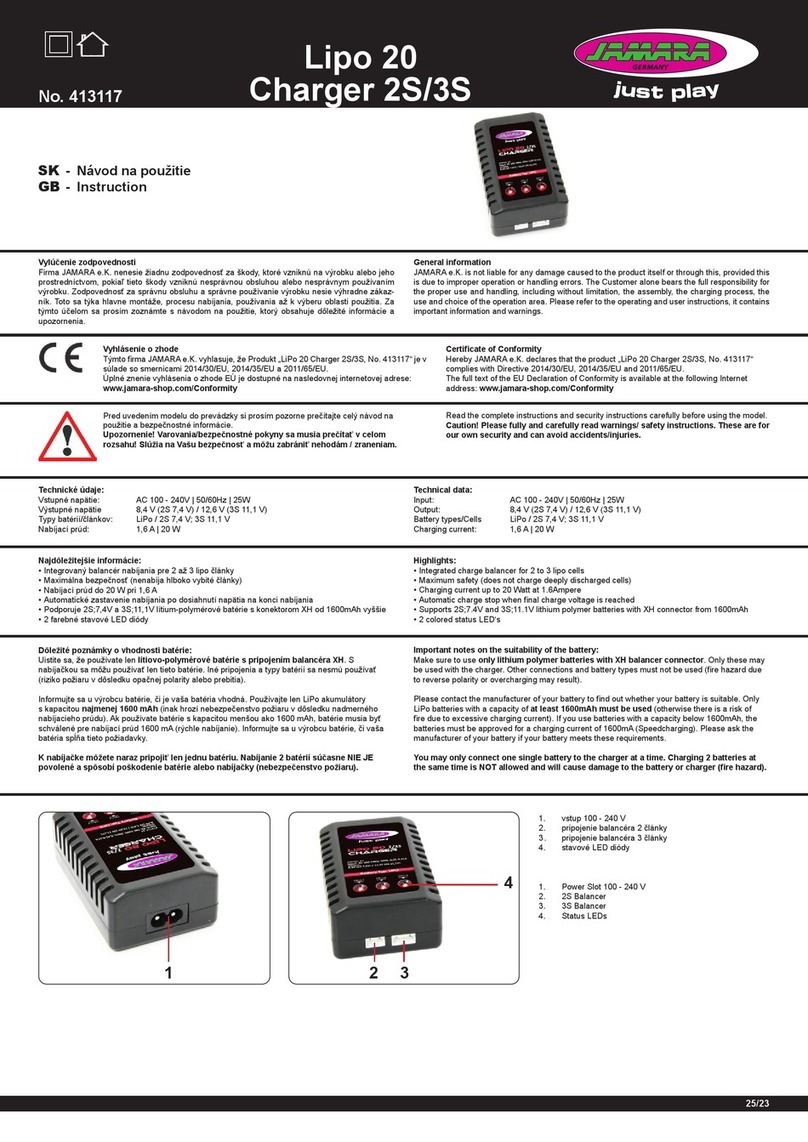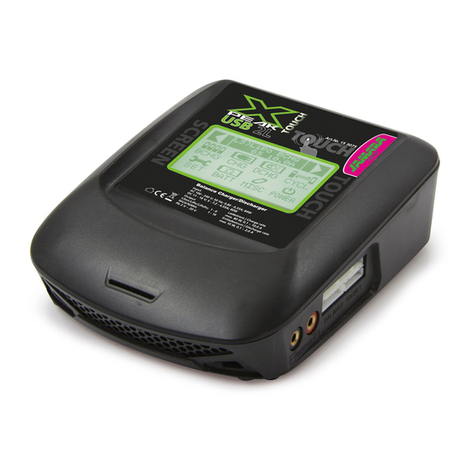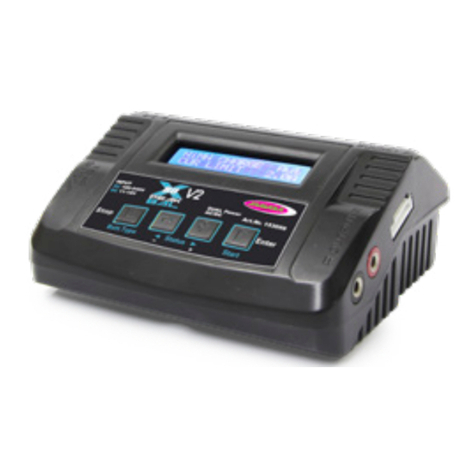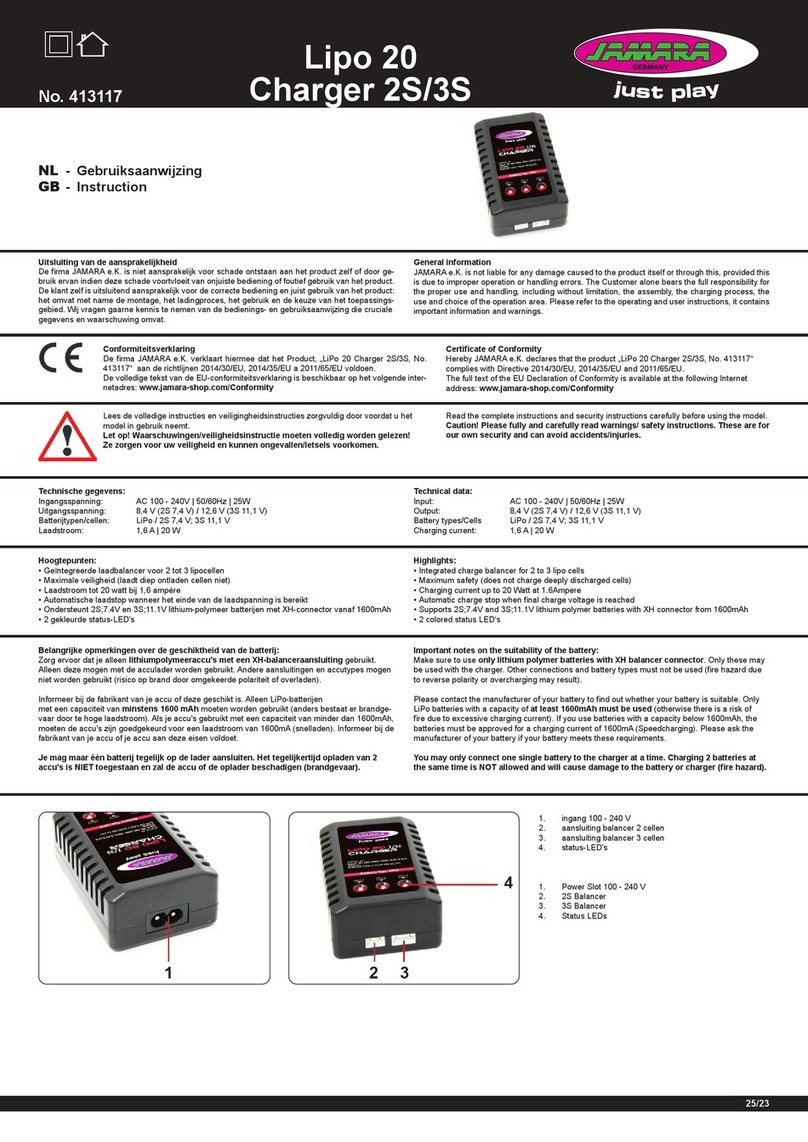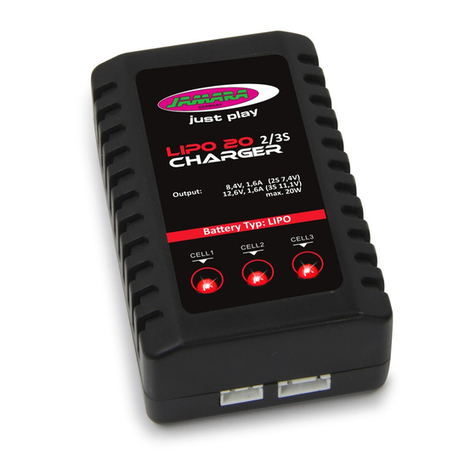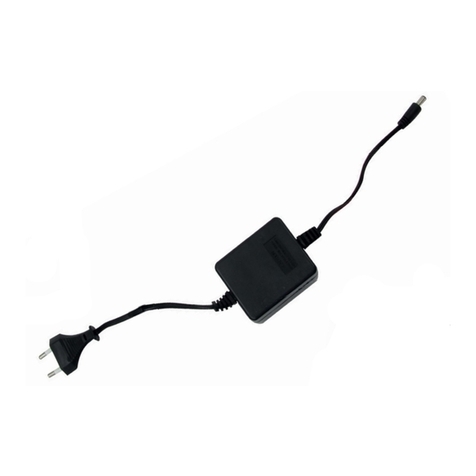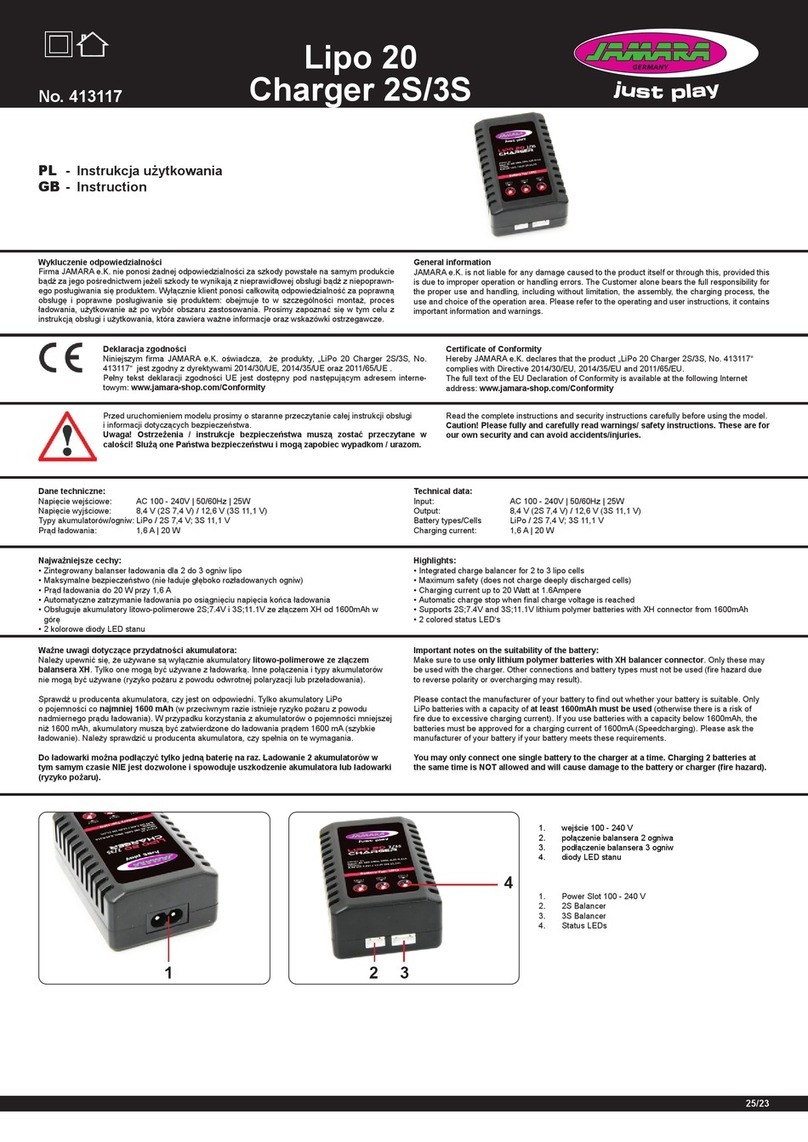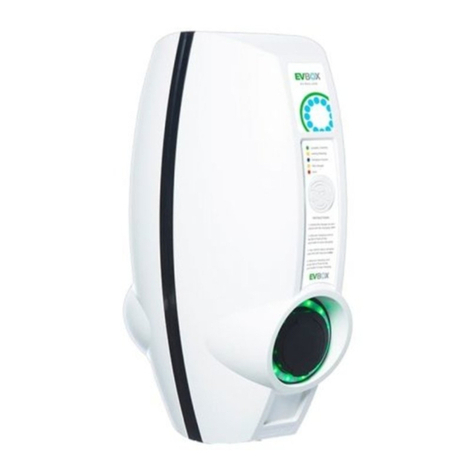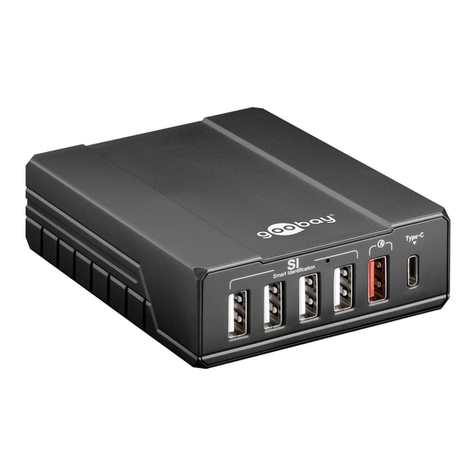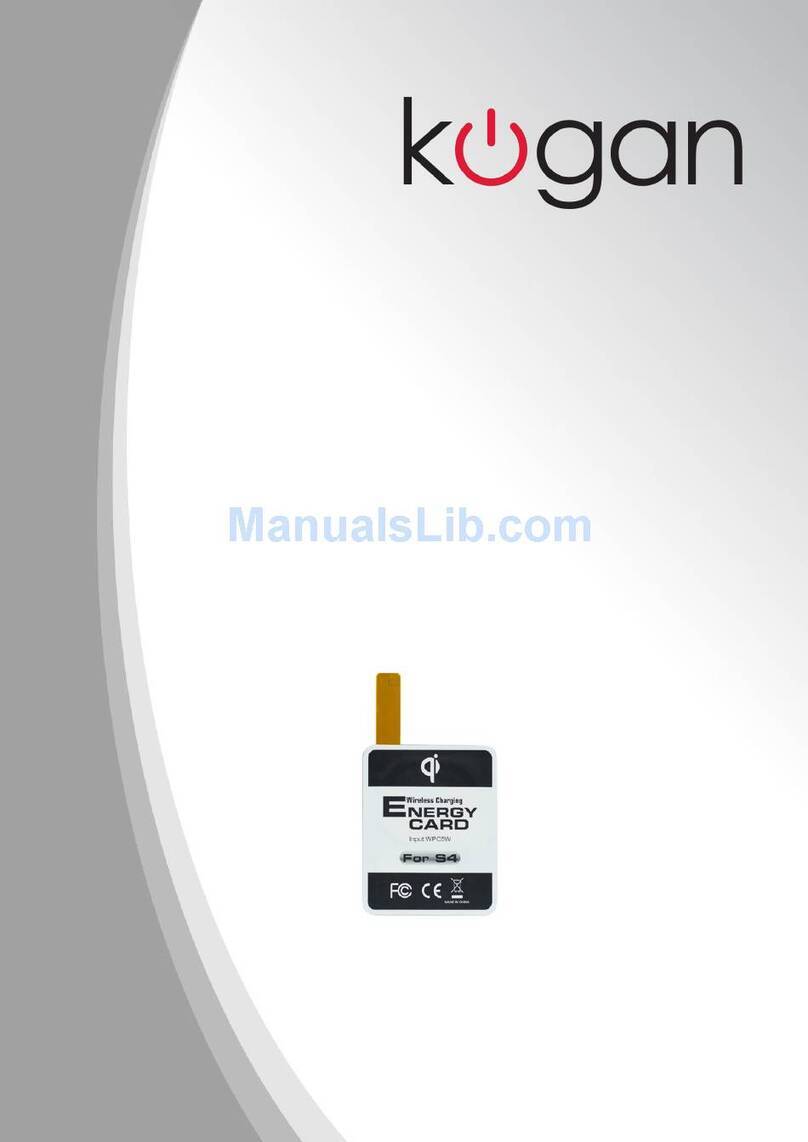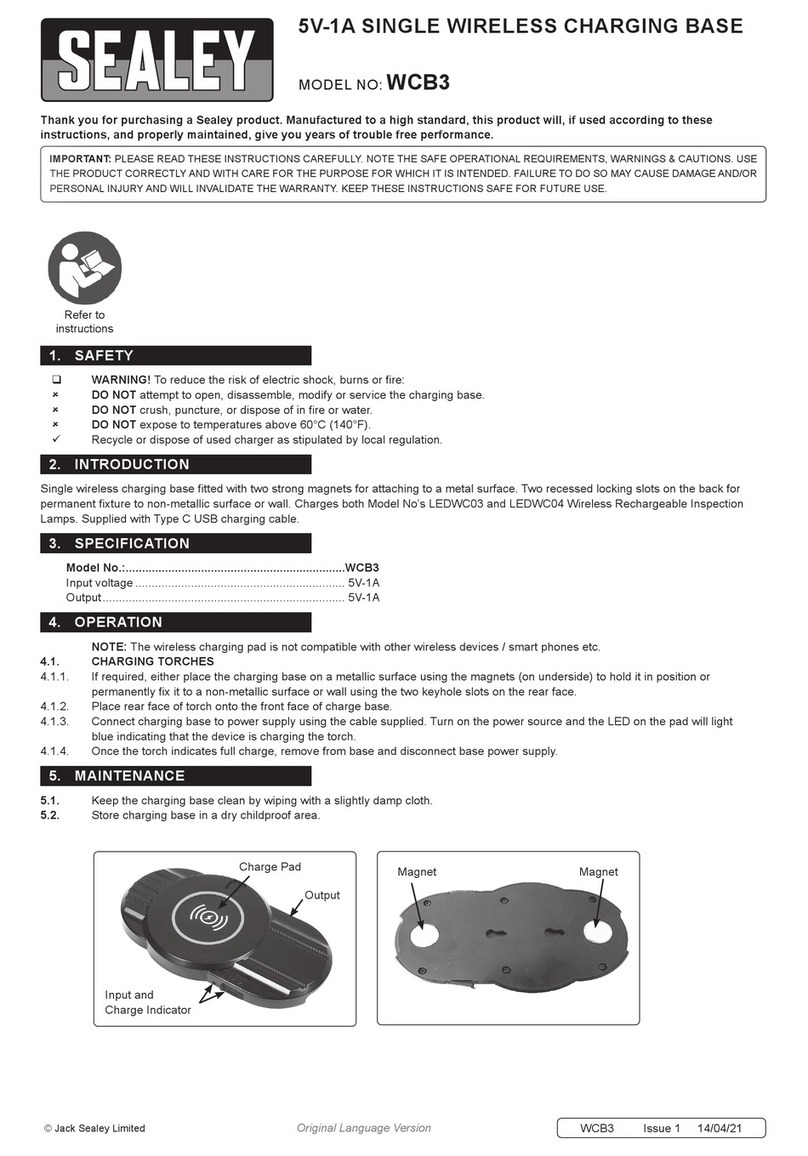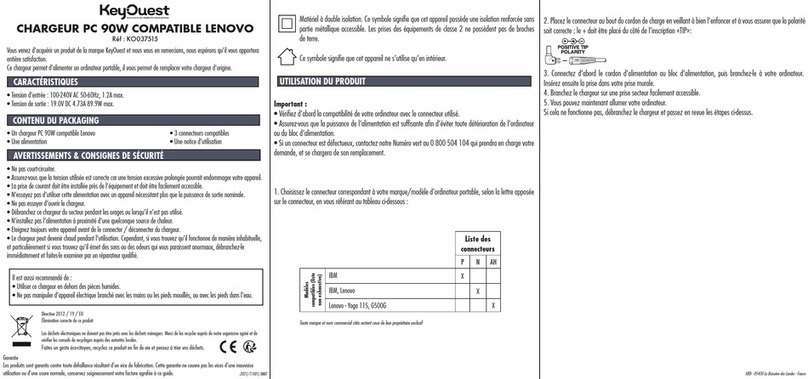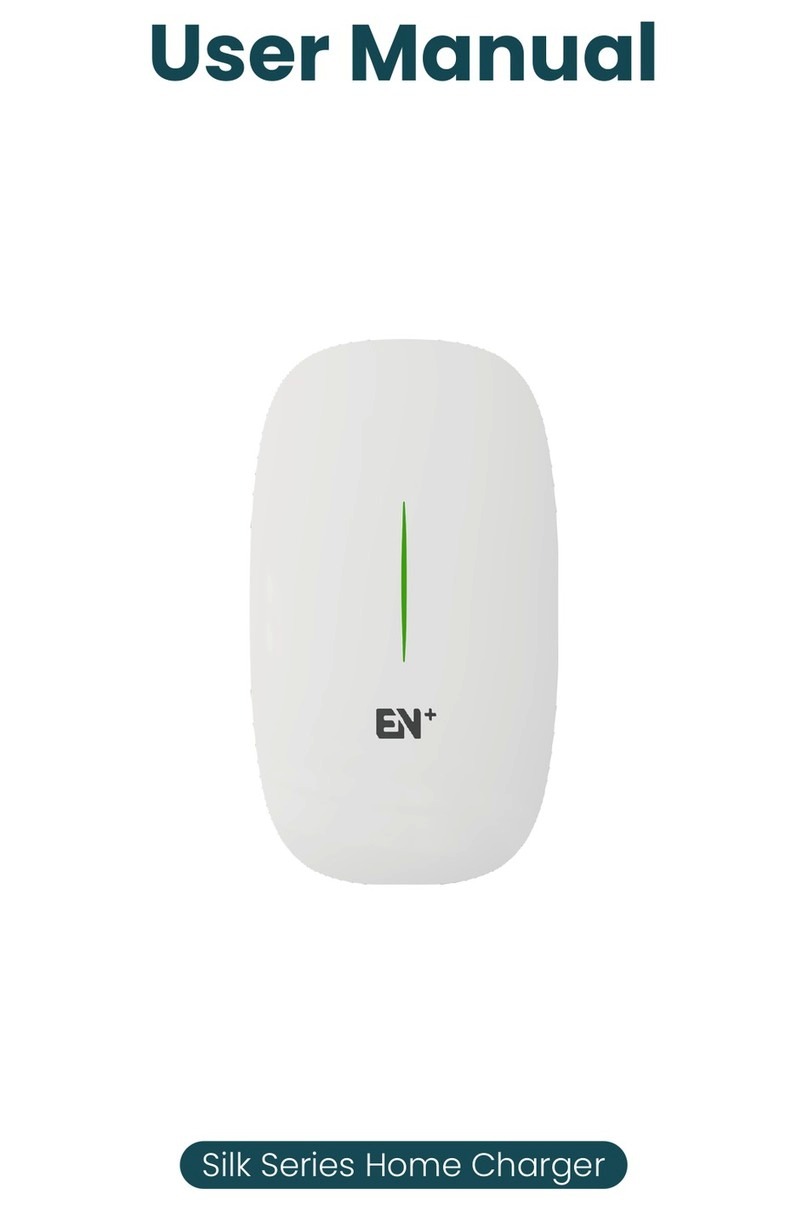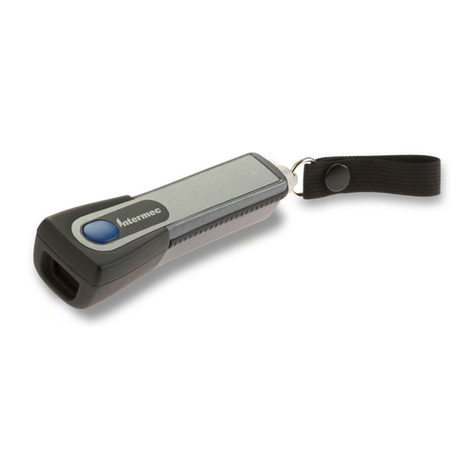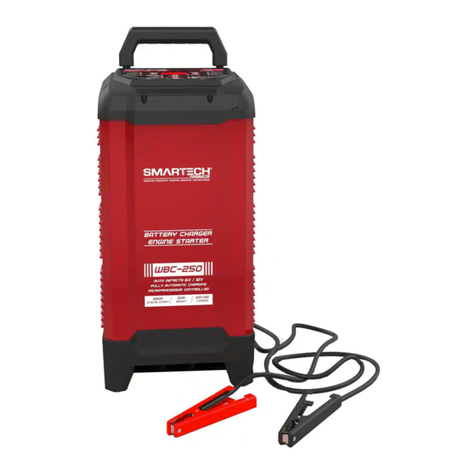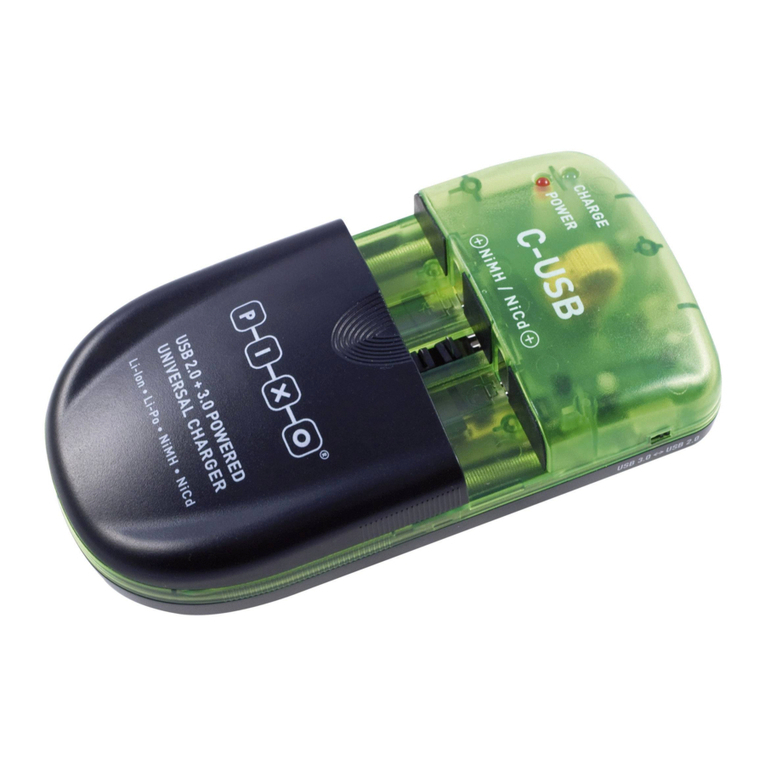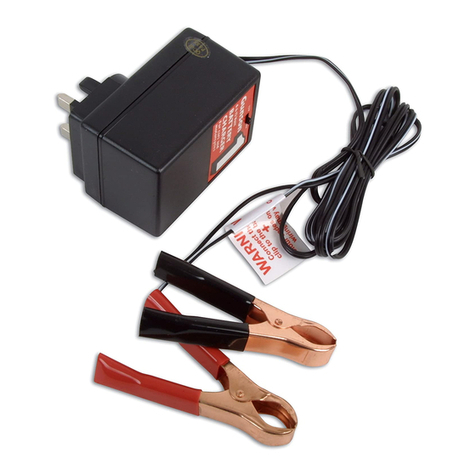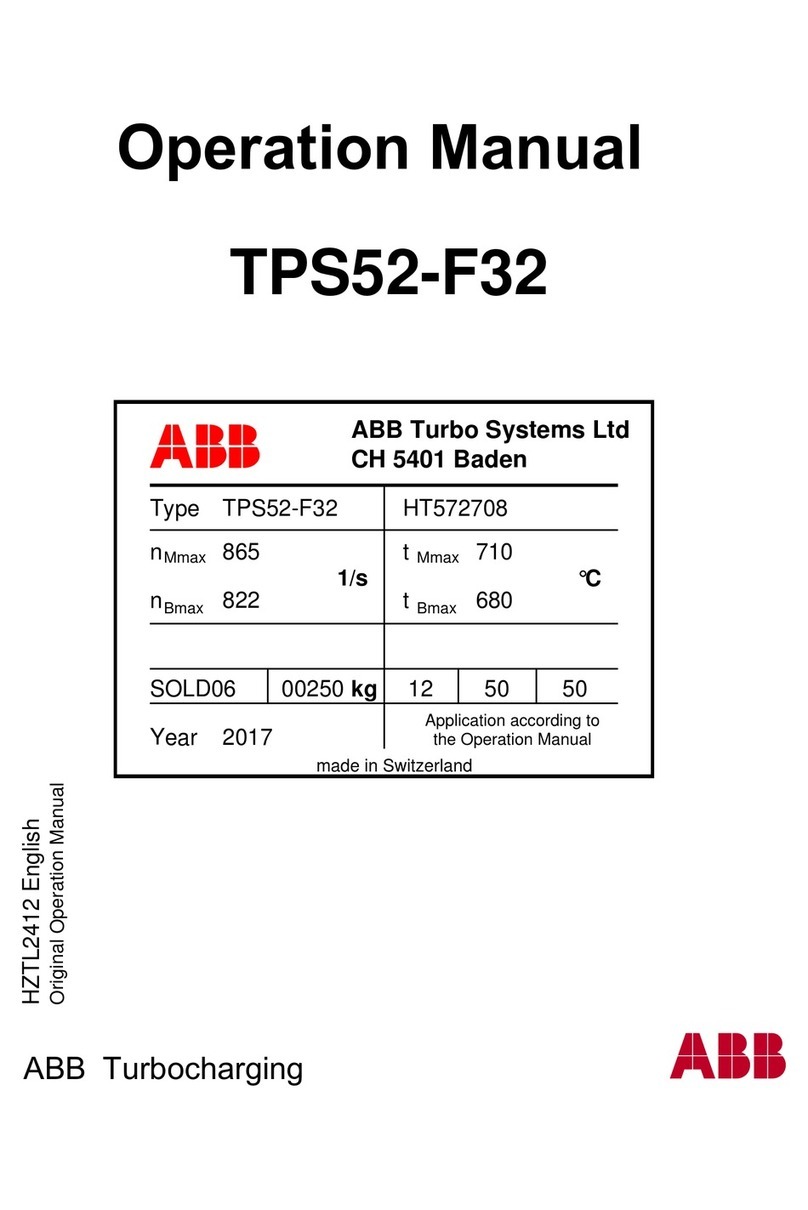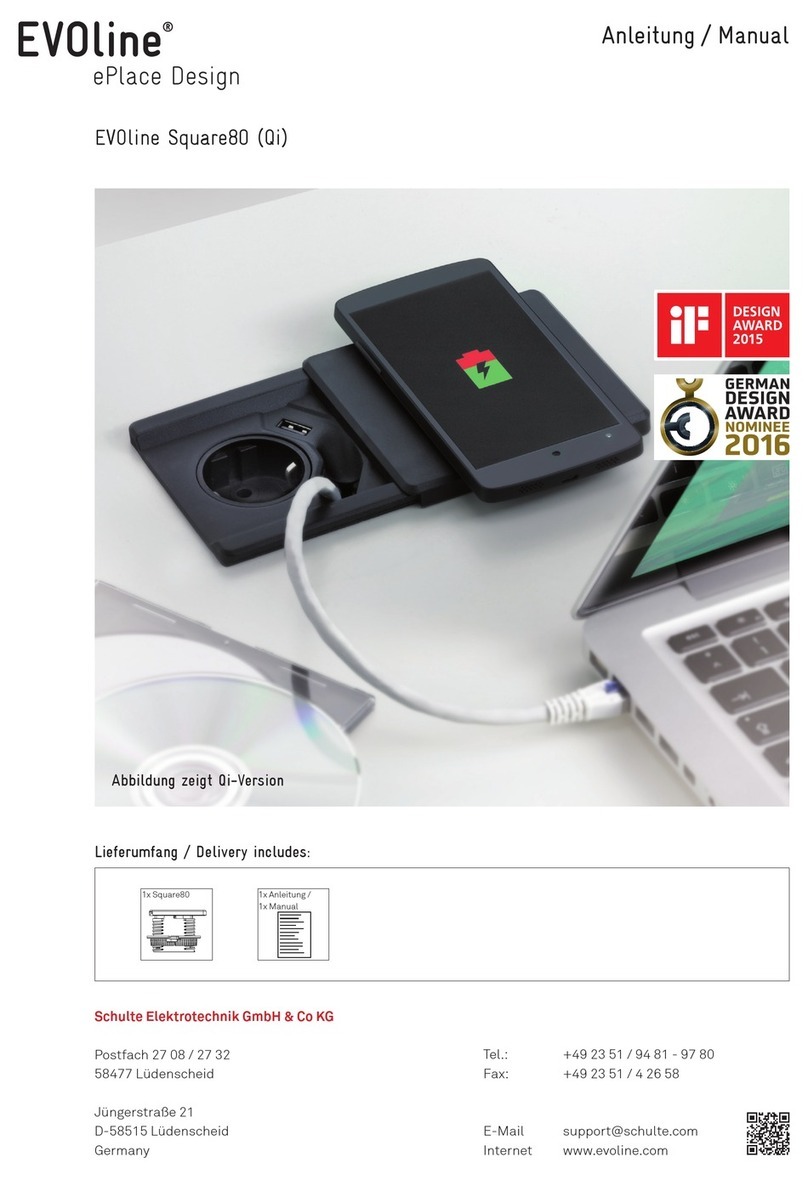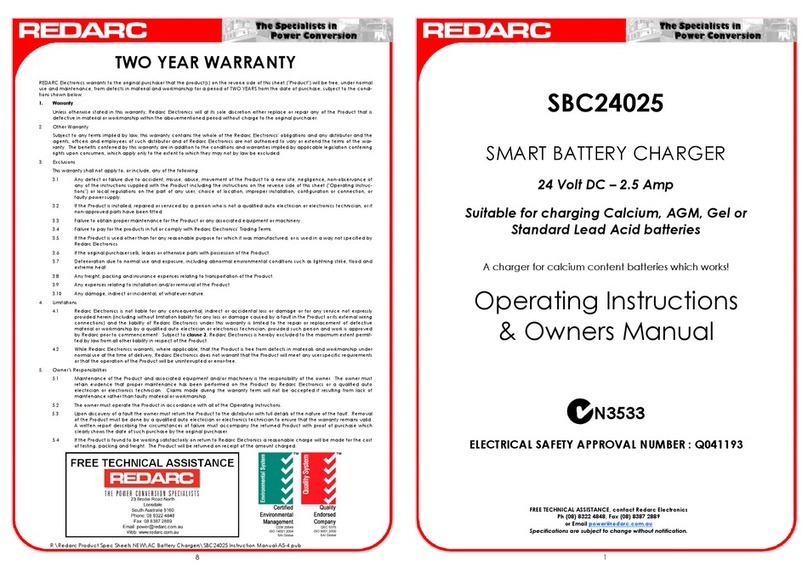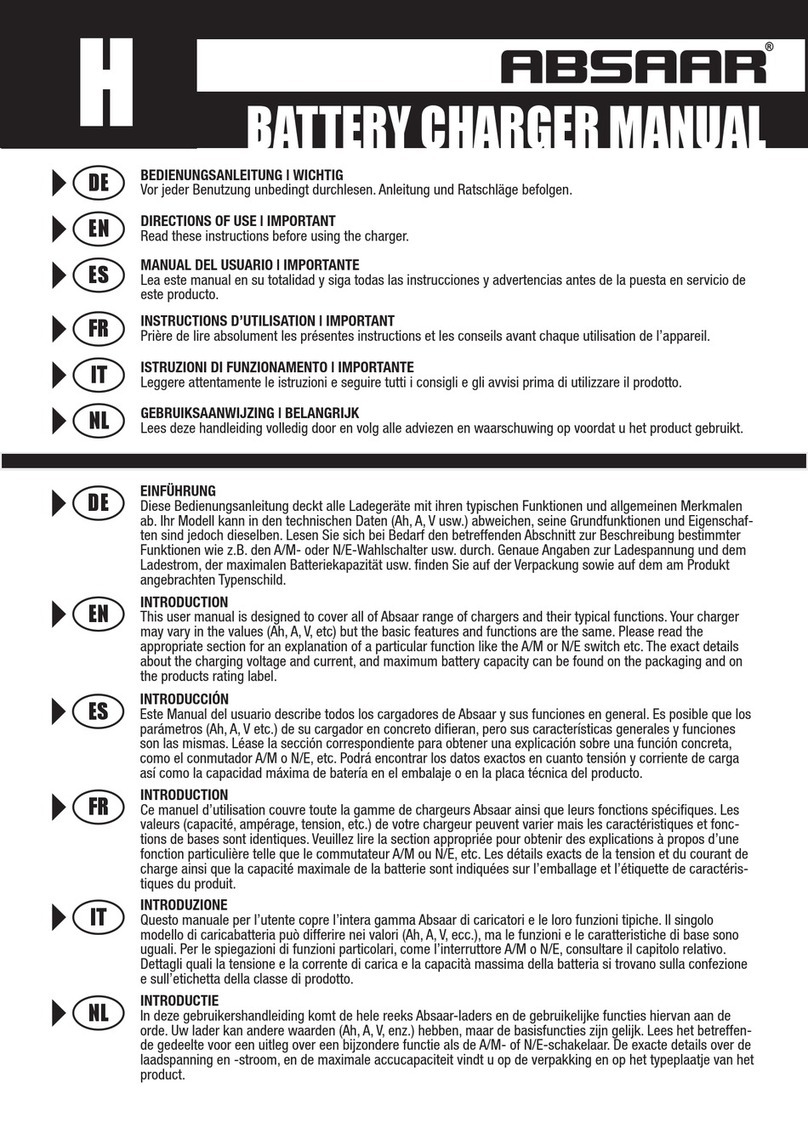
2
IT - Particolarità
Indipendente bilanciatore al litio all’interno
L’ caricatore ha un bilanciatore integrato per max. 6 Litio - celle (Balancer Adapterboard Univer-
sal, No. 153043, Cavo adattatore Balancer Universal, No. 153044). Il processo di carica diventa in
questo modo molto più sicuro e confortevole. Non è necessario collegare un bilanciatore separato
durante il processo di carica.
Scarico di batteria singolarmente equilibrata
Durante il processo di scarico il caricatore controlla ogni cella singolarmente. Errori sono visualizzati
sul display e il processo termina automaticamente se la tensione di una cella non è regolare.
Vari tipi di batterie al litio
Con questo caricatore possano essere caricato varie batterie al litio. Per esempio: batterie agli ioni
di litio, LiPo e le nuove celle LiFe.
Massima sicurezza
Delta-Peak-Sensibilità: Il caricabatterie controlla la tensione della batteria durante la carica. Appena
raggiunto o superato la tensione di carica della batteria, il dispositivo si spegne automaticamente.
Protezione automatica contro le sovratensioni
È possibile impostare il limite superiore della corrente di carica durante la ricarica del tuo NiCd o
NiMH. Questo è utile per batterie NiMH con bassa capacità in modalità di caricamento automatico.
Monitoraggio della corrente d´ingresso
Per evitare una scarica profonda della batteria, la tensione d’ingresso del caricatore è costante-
mente monitorata. Se il valore massimo sarà superato, il caricabatterie termina il processo auto-
maticamente.
Monitoraggio della temperatura con spegnimento programmabile*
Al caricatore po’ essere collegato un sensore di temperatura. Il quale po’ controllare la temperatura
della batteria no a 80°C.
* Questa funzione è solo ottenibile con il collegamento di un sensore di temperatura (No. 153056).
Quest’articolo non è incluso nel kit di consegna.
Limite di capacità
Per sicurezza è monitorata la capacità di carica. Inoltre è costantemente monitorato anche il tempo
di ricarica. Se la capacità di carica supera il valore massimo, il processo sarà terminato automati-
camente.
Limite di tempo delle operazioni
Per evitare errori, è anche possibile impostare manualmente il tempo di caricamento.
Funzionamento a cicli di carica / scarica
Le celle delle batterie possano anche usufruire di un programma per la rigenerazione delle celle
stesse. Per i dettagli esatti si prega di consultare i dati tecnici.
GB - Special features
Internal independent lithium battery balancer
The Charger has an integrated balancer connection for the included Balander board (up to 6-cell
lithium) (Optional Universal Balancer Board, No.153043, balancer adapter cable, No. 153044). It
isn‘t necessary to connect an external balancer for balance charging.
Balancing individual cells battery charging/discharging
During the process of discharging, the charger can monitor and balance each cell of the battery in-
dividually. Error message will be indicated and the process will be ended automatically if the voltage
of any single one cell is abnormal.
Adaptable to various type of lithium battery
Charger is adaptable to various types of Lithium batteries, such as Li-ion, LiPo and the new LiFe
series of batteries.
Maximum safety
Delta-peak sensitivity: the automatic charge termination program based on the principle of the Delta-
peak voltage detection. When the battery‘s voltage exceeds the threshold, the process will be ter-
minated automatically.
Automatic charging current limit
You can set up the upper limit of the charging current when charging your NiCd or NiMh battery. It is
useful for the NiMh battery of low impendance and capacity in the „Auto“ charging mode.
Input power monitoring
To portect the car battery used as DC input power from being damaged, its voltage keeps being
monitored. If it drops below the lower limit, the process will be ended automatically.
Temperatur monitoring with programmable cut-off
The battery‘s internal chemical reaction will cause the temperature of the battery to rise. If the tem-
perature limit is reached, the process will be terminated.
*This function is available by connecting optional temperatur probe (Ord. No. 153056), which is not
included in our package.
Capacity limit
The charging capacity is always calculated as the charging current multiplied by time. If the charging
capacity exceeds the limit, the process will be terminated automatically when you set the maximum
value.
Processing time limit
You can also limit the maximum process time to avoid any possible defect.
Cyclic charging/discharging
1 to 5 cyclic and continuous process of charge>discharge or discharge>charge is operable for bat-
tery refreshing and Balancing to simulate the battery‘s activity.
Messa in servizio del caricabatterie
Lo caricatore in alternativa può essere utilizzato con due fonti di tensione differenti. È possibile usare
l‘energia del cavo di alimentazione di una normale presa CA o di una batteria a 12 V o anche di un
potente alimentatore stabilizzato.
Collegare uno degli ingressi alla rete di Vostra scelta. Quando è collegato a una fonte di alimentazio-
ne a 12 V, accertarsi di rispettare la corretta polarità. Collegare il morsetto rosso al polo positivo (+) e
il nero al polo negativo (-) alimentazione a batteria o alimentazione.
Durante l´accensione viene segnalato „Charge Discharge“. In quell´istante il processore controlla
la caricabatteria e la fonte di alimentazione. Se trova un errore, per esempio la tensione d’ingresso
è inferiore a 11 V o 15 V, lo segnala con un messaggio sul display e con un segnale acustico. Se
questo è il caso, controllare l‘alimentazione
Avviso importante:
Mai usare entrambe le fonti energetiche allo stesso tempo, il caricabatterie così va inevita-
bilmente danneggiato
Il collegamento con la batteria da caricare o scaricare è compiuto da prese di 4mm di 2 colori diversi.
Collegate la batteria con queste prese. Il (+) della batteria deve essere collegato con la presa rossa
e il (–) con la presa nera. Usate solo cavi di ricarica di alta qualità.
Durante la carica o la scarica di una batteria al litio, è necessario utilizzare per ragioni di sicurezza
la funzione di bilanciamento del caricatore. Solo in questo modo, le celle al litio sono perfettamente
protette.
Per fare ciò, oltre alle due porte principali dovete collegare anche il sistema di bilanciamento della
batteria con il caricabatterie. Se il bilanciatore non è usato, la modalità di carica o scarica viene
effettuata senza controllo della tensione delle singole celle. Inoltre, le tensioni delle singole celle non
possono essere visualizzati sul display.
Using your charger for the fi rst time
The Charger is tted with 2 power inputs which gives you the choice of powering the unit from the
household mains supply (220 V AC) or via 12 V DC. The 12 V DC can be either a vehicle battery or
a stabilised transformer.
Connect the charger to an input of your choice, if using 12 V pay particular attention to the polarity.
The red crocodile clip must be connected to the plus pole (+) and the black clip to the minus pole (-).
After connection Info menu and then the set-up menu is appears rst. If an error is encountered, for
example if the input voltage is outside the allowed range of 10-15 V, a message will be displayed and
the buzzer will sound. Disconnect the power supply and rectify the fault.
WARNING!
Never connect both power inputs simultaneously as this will destroy the charger!
Battery packs to be charged or discharged are attached to the charger via 2 colour coded banana
sockets using a good quality charging cable. Make sure that the plus (+) pole of the battery is con-
nected to the red socket on the charger and that the minus (-) pole of the battery is connected to the
black socket of the charger.
When charging or discharging Lithium packs, always use the balancer function of the charger. This
will not only provide protection for your cells, but also ensure maximum ef ciency and long life.
To do so, you must connect both the charging cable and the balancer plug/socket (balancerboard
included). Not doing this will result in the individual cells not being protected and you will not be able
to monitor the individual cell voltage in the display.
Connessioni e Modi di controllo
1 Ingresso 230 V
2 Ori cio di carico USB
3 Ingresso 10 - 18 V
4 Collegamento per il sensore di temperatura
Connettore USB JR (Software / PC)
Connessione di servo
5 Ventilatore
6 Porta di ricarica rosso = più (+)
Nero = meno (-)
7 Attacchi di bilanciatore (1 - 6)
8 LED Display con Touchscreen, illuminato.
Connections and Controls
1 230 V AC Input
2 USB charging socket
3 10 - 18 V DC Input
4 Temperature sensor socket
USB-JR socket
Servo socket
5 Cooler
6 Charge cabel sockets red = plus (+)
black = minus (-)
7 Balancer sockets (1 - 6)
8 LED screen with Touch screen and light
1 2 3 54 7
6
8


